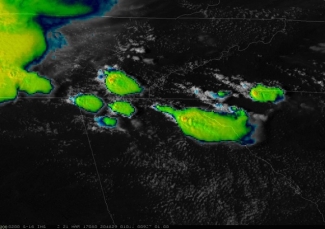The National Oceanic and Atmospheric Administration’s latest generation of Geostationary Operational Environmental Satellites (GOES), known as the GOES-R Series, is the nation’s most advanced fleet of geostationary weather satellites. Geostationary satellites orbit the Earth’s equatorial plane at a speed matching the Earth’s rotation. This allows them to stay in a fixed position in the sky, remaining stationary with respect to a point on the ground. GOES satellites continually view the Western Hemisphere from approximately 22,300 miles above Earth.
Two senior scientists from the program recently visited UGA to present experiences from their work with students.
Dan Lindsey, Senior Scientific Advisor for NOAA's GOES-R Series Satellite Program and UGA alumnus (B.S. mathematics, ‘98), and Steve Goodman, Senior Advisor to NOAA's GOES-R Program, presented a talk on scientific advances in NOAA's weather satellite program on Oct. 24. A research meteorologist at the NOAA Center for Satellite Applications and Research. Lindsey’s research interests include remote sensing of mesoscale phenomena, especially convective storms, cloud physics, and algorithm development. Goodman is an adjunct professor of Atmospheric Science at the University of Alabama in Huntsville, who conducts research in satellite and radar remote sensing, nowcasting of severe storms and high impact weather, and lightning and precipitation process studies.
"Our program is growing and attracting top students. It is amazing that high level NOAA officials chose our program on its tour of universities,” said Marshall Shepherd, Georgia Athletic Association Distinguished Professor and director of the atmospheric sciences program at UGA. “They see the efficacy and reputation of UGA's program. Our students get access to the latest updates on the U.S. weather satellite programs and direct access to people that might hire them one day."
Lindsey and Goodman discussed the imaging aspects of the GOES-R series. There are currently two GOES-R satellites in orbit, GOES East and GOES West, each outfitted with an advanced baseline imager that increases the quality of the images the satellites capture.
“The advanced baseline imager is the primary instrument aboard the GOES-R series of environmental satellites,” said Lindsey. “The imager now takes an image every minute allowing us to make movies instead of just having still images. We can see storms rotating, wildfires forming and monitor storm formations.”
Goodman focused on the Geostationary Lightning Mapper, the first instrument of its kind. GLM can detect the momentary changes in an optical scene, indicating the presence of lightning and measures total lightning activity continuously over the Americas and adjacent oceanic regions.
“Trends in total lightning available from the GLM provide critical information to forecasters, allowing them to focus on developing severe storms much earlier, before these storms produce damaging winds, hail or even tornadoes,” said Goodman. “This leads to improved aviation route planning, increased warning time for severe storms and early recognition of conditions conducive to lightning-ignited wildfires.”
Since 1975, GOES have provided continuous imagery and data on atmospheric conditions and solar activity. They have even aided in search and rescue of people in distress. GOES data products have led to more accurate and timely weather forecasts and better understanding of long-term climate conditions. NASA builds and launches GOES, and NOAA operates them.
Image: VIS/IR “Sandwich” imagery, courtesy of NOAA.

